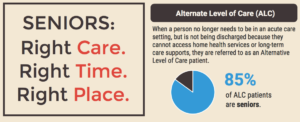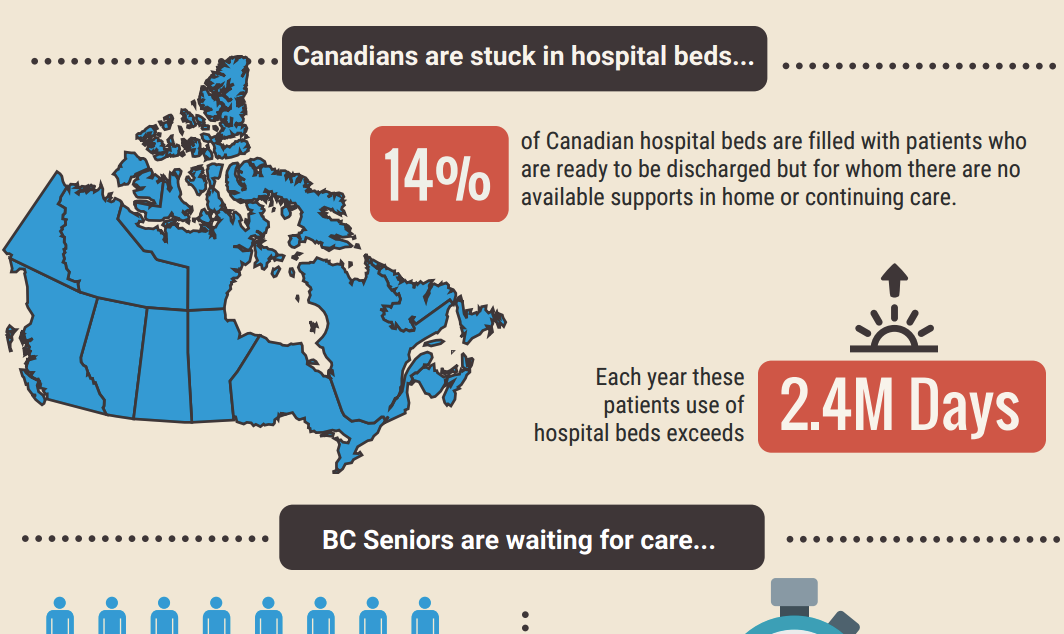As we have seen from recent news coverage, significant concerns exist regarding the overcrowding of Emergency Rooms (ER) in the Fraser Health region.[i] As a result, some have called for increased investments into primary and acute care to prevent unsafe overcrowding. While this seems like a common-sense solution, it may only have a temporary band aid effect as it will not address the root cause of the problem, which is the lack of appropriate supports in home and community care.

In British Columbia approximately thirteen percent of hospital beds are filled with patients who are ready to be discharged but for whom there is no appropriate place to go.[ii] These patients, known as Alternate Level of Care (ALC) patients, spend on average 182 days in care limbo, according to one pan-Canada study.[iii] British Columbia’s health authorities report that about half of ALC patients are awaiting discharge into long-term care.[iv]
These ALC patients significantly contribute to hospital ward overcrowding, occupying up to the 7,500 beds each day across the country.[v] In an attempt to reduce ER ward overflow, these patients are often cared for in hallways, a practice that the Fraser Health Authority (FHA) stopped earlier this year due to concerns about the quality of care being provided in non-approved settings. These concerns are likely justified, given the evidence suggesting that frail and elderly patients often deteriorate in ALC settings are well documented.[vi]
Not only do ALC patients inadvertently create overcrowding, but they also cause fiscal challenges as well. When you consider the fact that an acute care bed costs on average $1,200 per day to operate versus a residential care bed that costs only $200 per day, it’s easy to see the potential savings. In a 2015 report, the BC Care Providers Association (BCCPA) estimates that if 50% of ALC days were to be reduced by transitioning elderly ALC patients to residential care, it could generate over $200 million in cost savings annually. [vii] The problem of ALC beds not only creates fiscal challenges, but quality of care and access issues as well. The Wait Time Alliance (WTA), for example, has noted that the ALC issue represents the single biggest challenge to improving wait times across the health care system. [viii]
For these reasons the BC Care Providers Association (BCCPA) has recommended that the Health Authorities begin transitioning funds from their acute care budgets into the Home and Community Care sector. As outlined in a 2015 BCCPA report, transitioning just one percent of regional acute care budgets each year for five years could generate $320 million for the home and community care sector. This additional funding could translate to approximately 4,400 new long-term care beds or 12 million more home care hours.[ix]
In response to these recommendations, the BC Government announced on March 9 that it would be investing over $500 million over the next four years improve care for seniors across the system.[x] In addition, health authorities have been directed to increase their base home and community care budget by $200 million. [xi] The majority of this funding will be used to increase staffing ratios in BC’s residential care homes, improve access to home health services, purchase new equipment, and improve seniors’ quality of life through access to allied health services such as recreational therapists, among other initiatives. [xii] This funding will also have secondary benefits, such as preventing the admission of frail and elderly seniors from admission into the hospital by providing more appropriate clinical care in their current home setting.
While this funding is significant, it needs to be supported by comparable investments into home and community care at the health authority level in order to expand services so that ALC patients can be transitioned back into the community faster. This will not only improve care for the frail and the elderly, but also address emergency room overcrowding by tackling the issue’s root cause.
In this regard, the Fraser Health Authority (FHA) has demonstrated leadership by focusing on reducing ALC days. As outlined in the FHA’s September 2016 report card, the health authority has set a target to reduce ALC days from their current levels at 17% to 10% of all hospital days, as well as aiming to reduce the total number of long-stay patients in acute care.[xiii] The FHA has also begun transitioning resources from acute to community care, starting by closing 100 acute care beds last year in order to fund the construction of 400 new residential care beds,[xiv] as well as to invest in the creation of a Frail Seniors Care Team. [xv]
Our organization applauds the work that Fraser Health it is doing, as reinvesting in home and community is a necessary step in the right direction. BCCPA further encourages the other health authorities to follow FHA’s lead and begin similar transitions, specifically by setting a target that by 2021 no more than five percent of all acute care beds be occupied by a senior awaiting care in the community.[xvi]
The evidence is clear that providing additional residential care and home support services will help to maintain the overall sustainability of B.C.’s health care system into the future, as well as addressing the root cause of much of the overcrowding of B.C.’s acute care hospitals.
**This BCCPA opinion column was published in Vancouver Sun newspaper.
***
End Notes
[i] Vancouver Sun. Fraser Health rule behind unsafe conditions, doctors charge. Sam Cooper. March 3, 2017. Accessed at: http://vancouversun.com/news/local-news/unsafe-er-conditions-caused-by-fraser-health-ceo-surrey-doctors-claim
[ii] Quality-Innovation-Collaboration: Strengthening Seniors Care Delivery in BC. BC Care Providers Association. September 2015. Accessed at: https://bccare.ca/wp-content/uploads/BCCPA-White-Paper-QuIC-FINAL-2015.pdf
[iii] Globe and Mail. Thousands of Canadians languish in limbo as they wait for place in long term care. December 23, 2016. Accessed at: http://www.theglobeandmail.com/news/national/thousands-of-canadians-languish-in-limbo-as-they-wait-for-place-in-long-term-care/article33424226/
[iv] Exploring alternative level of care (ALC) and the role of funding policies: An evolving evidence base for Canada. Canadian Health Services Research Foundation. September 2011. Accessed at: http://www.cfhi-fcass.ca/sf-docs/default-source/commissioned-research-reports/0666-HC-Report-SUTHERLAND_final.pdf
[v] Vancouver Sun. Fraser Health rule behind unsafe conditions, doctors charge. Sam Cooper. March 3, 2017. Accessed at: http://vancouversun.com/news/local-news/unsafe-er-conditions-caused-by-fraser-health-ceo-surrey-doctors-claim
[vi] Globe and Mail. Thousands of Canadians languish in limbo as they wait for place in long term care. December 23, 2016. Accessed at: http://www.theglobeandmail.com/news/national/thousands-of-canadians-languish-in-limbo-as-they-wait-for-place-in-long-term-care/article33424226/
[vii] Quality-Innovation-Collaboration: Strengthening Seniors Care Delivery in BC. BC Care Providers Association. September 2015. Accessed at: https://bccare.ca/wp-content/uploads/BCCPA-White-Paper-QuIC-FINAL-2015.pdf
[viii] Wait Time Alliance. 2015. Eliminating Code Gridlock in Canada’s Health Care System: 2015. Wait Time Alliance Report Card. Accessed at: http://www.waittimealliance.ca/wp-content/uploads/2015/12/EN-FINAL-2015-WTA-Report-Card.pdf
[ix] Quality-Innovation-Collaboration: Strengthening Seniors Care Delivery in BC. BC Care Providers Association. September 2015. Accessed at: https://bccare.ca/wp-content/uploads/BCCPA-White-Paper-QuIC-FINAL-2015.pdf
[x] BBC Government. Significant funding boost to strengthen care for B.C. seniors. March 2017. Accessed at: https://news.gov.bc.ca/releases/2017HLTH0052-000529
[xi] Ibid.
[xii] BC Ministry of Health. An Action Plan to Strengthen Home and Community Care for Seniors. March 2017. Accessed at: http://www.health.gov.bc.ca/library/publications/year/2017/home-and-community-care-action-plan.pdf
[xiii] Fraser Health. Our Health Care Report Card. September 2016. Accessed at: http://www.fraserhealth.ca/media/20160927ReportCardAllSites.pdf
[xiv] BCCPA. Closure of Acute Care Beds in Fraser Health a Step in Right Direction. February 19, 2016. Accessed at: https://bccare.ca/2016/02/closure-of-acute-care-beds-in-fraser-health-a-step-in-right-direction/
[xv] Fraser Health. Our Health Care Report Card. September 2016. Accessed at: http://www.fraserhealth.ca/media/20160927ReportCardAllSites.pdf
[xvi] BCCPA. Strengthening Seniors Care: A Made-in-BC Roadmap. January 2017. Accessed at: https://bccare.ca/wp-content/uploads/2017/01/BCCPA_Roadmap_ExecSummary_Jan2017.pdf





